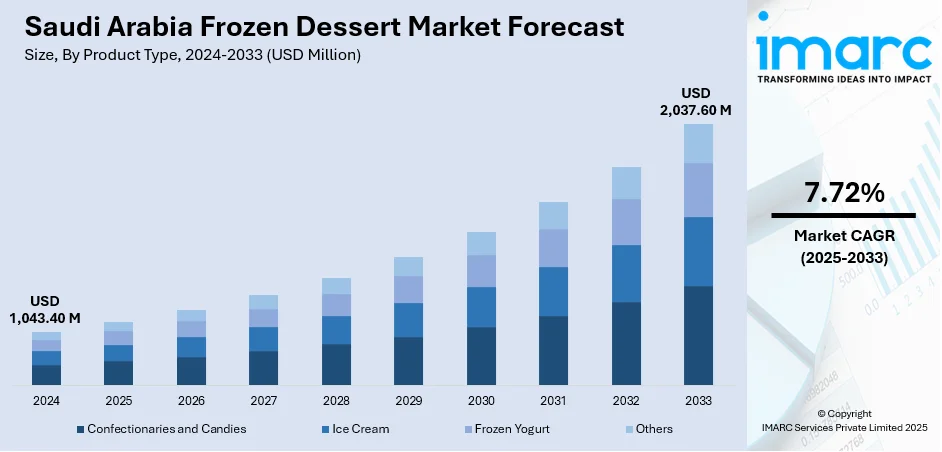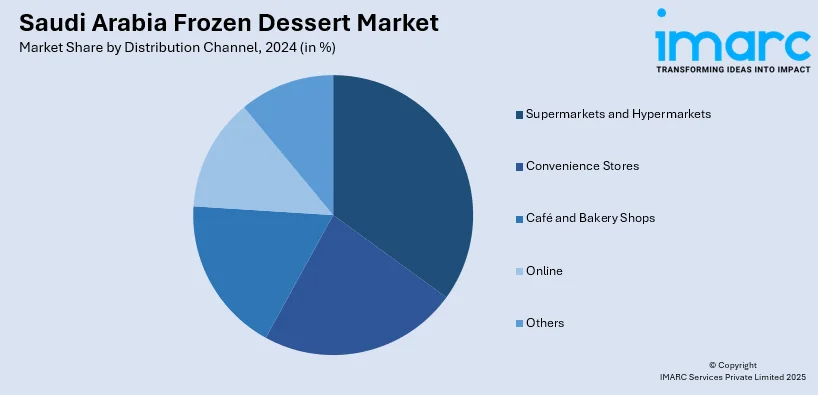
Saudi Arabia Frozen Dessert Market Size, Share, Trends and Forecast by Product Type, Category, Distribution Channel, and Region, 2025-2033
Saudi Arabia Frozen Dessert Market Overview:
The Saudi Arabia frozen dessert market size reached USD 1,043.40 Million in 2024. Looking forward, IMARC Group expects the market to reach USD 2,037.60 Million by 2033, exhibiting a growth rate (CAGR) of 7.72% during 2025-2033. Rising health consciousness, the young population's growing appetite for indulgent yet innovative treats, increasing disposable incomes, and the expansion of international and local premium brands are among the key factors propelling Saudi Arabia’s frozen dessert market, alongside cultural shifts that are embracing Westernized eating habits and diversified retail channels, including e-commerce and food delivery.
|
Report Attribute
|
Key Statistics
|
|---|---|
|
Base Year
|
2024
|
|
Forecast Years
|
2025-2033
|
|
Historical Years
|
2019-2024
|
| Market Size in 2024 | USD 1,043.40 Million |
| Market Forecast in 2033 | USD 2,037.60 Million |
| Market Growth Rate 2025-2033 | 7.72% |
Saudi Arabia Frozen Dessert Market Trends:
Climate and Weather Extremes: A Natural Catalyst for Frozen Dessert Demand
Saudi Arabia's desert climate is at the root of driving the development of its frozen dessert market. With daytime temperatures frequently reaching more than 40°C (104°F) for most of the year, there is a necessity rather than a luxury for cooler dishes. The dry climate, with its long summers and low rainfall, directly prompts consumers to find relief in chilled food and drinks, especially frozen desserts such as ice creams, sorbets, frozen yogurts, and gelato. This climatic need is supplemented by the nation's cultural predilection towards outdoor socializing, particularly in the evenings. Whether at family excursions, café gatherings, or festival parties, frozen treats are both a comfort food and a cooling indulgence. Businesses take advantage by providing mobile ice cream vendors and pop-up kiosks in heavily trafficked outdoor areas. The outcome is a highly ingrained consumption pattern that closely adheres to the nation's environmental factors. In addition, urbanization has driven demand further, with increased temperatures in urban areas as a result of the urban heat island phenomenon. With cities such as Riyadh, Jeddah, and Dammam rapidly expanding, the demand for frozen desserts is expected to continue increasing.

To get more information on this market, Request Sample
Shifting Consumer Lifestyles and the Rise of Health-Conscious Indulgence
Another key driver of Saudi Arabia's frozen dessert market is consumer lifestyle shift, specifically the rising awareness and adoption of health-oriented dietary practices. Whereas in the past frozen desserts were considered sinful and high-sugar indulgences, the market has changed to suit a more globally intelligent, aware, and nutrition-driven population. This transformation is driven by a number of factors. To begin with, the Kingdom's Vision 2030 plan has ignited extensive public health drives to curb obesity, diabetes, and other lifestyle diseases. Consumers are consequently seeking better-for-you options in the form of low-fat, dairy-free, sugar-free, and plant-based frozen treats. Producers and retailers have swiftly followed suit by expanding their ranges with probiotic-enhanced frozen yogurts, keto-friendly ice creams, and vegan sorbets prepared with almond, coconut, or oat milk. Besides this, the popularity of fitness culture, reflected in the proliferation of gyms, wellness centers, and social media personalities who evangelize healthy lifestyles—has reset the definition of indulgence. Rather than going cold turkey on desserts, most Saudis now want alternatives that complement their nutritional aims. This has created opportunities for high-end and functional frozen dessert categories, including those enhanced with protein or collagen.
Saudi Arabia Frozen Dessert Market Segmentation:
IMARC Group provides an analysis of the key trends in each segment of the market, along with forecasts at the region/country level for 2025-2033. Our report has categorized the market based on product type, category, and distribution channel.
Product Type Insights:
- Confectionaries and Candies
- Ice Cream
- Frozen Yogurt
- Others
The report has provided a detailed breakup and analysis of the market based on the product type. This includes confectionaries and candies, ice cream, frozen yogurt, and others.
Category Insights:
- Conventional
- Sugar-free
A detailed breakup and analysis of the market based on the category have also been provided in the report. This includes conventional and sugar-free.
Distribution Channel Insights:

- Supermarkets and Hypermarkets
- Convenience Stores
- Café and Bakery Shops
- Online
- Others
The report has provided a detailed breakup and analysis of the market based on the distribution channel. This includes supermarkets and hypermarkets, convenience stores, café and bakery shops, online, and others.
Regional Insights:
- Northern and Central Region
- Western Region
- Eastern Region
- Southern Region
The report has also provided a comprehensive analysis of all the major regional markets, which include Northern and Central Region, Western Region, Eastern Region, and Southern Region.
Competitive Landscape:
The market research report has also provided a comprehensive analysis of the competitive landscape. Competitive analysis such as market structure, key player positioning, top winning strategies, competitive dashboard, and company evaluation quadrant has been covered in the report. Also, detailed profiles of all major companies have been provided.
Saudi Arabia Frozen Dessert Market News:
- October 2024: Sour Sally, an Indonesian frozen yogurt brand, announced its expansion into Saudi Arabia, planning to open 15 outlets across the Kingdom. The brand is known for its health-focused offerings, including the Black Sakura frozen yogurt, which is low in calories and sugar, and made from premium Italian ingredients. This expansion introduces innovative, health-conscious dessert options to the Saudi market, aligning with the escalating demand for healthier indulgences.
- September 2023: Sawani, a Saudi camel dairy company, launched its first Noug store in Riyadh, offering a range of camel milk-based products, including frozen desserts like gelato. This initiative aligns with Saudi Vision 2030, aiming to diversify the economy and promote traditional foods. Noug's offerings cater to health-conscious consumers seeking nutritious and innovative dessert options.
- May 2023: Siwar Foods, a Saudi FMCG company, partnered with France's Sarl So Mochi to introduce mochi ice cream to the Middle East, starting with Saudi Arabia. These frozen desserts, combining chewy rice dough with premium ice cream, cater to Gen Z's preferences influenced by social media trends.
Saudi Arabia Frozen Dessert Market Report Coverage:
| Report Features | Details |
|---|---|
| Base Year of the Analysis | 2024 |
| Historical Period | 2019-2024 |
| Forecast Period | 2025-2033 |
| Units | Million USD |
| Scope of the Report |
Exploration of Historical Trends and Market Outlook, Industry Catalysts and Challenges, Segment-Wise Historical and Future Market Assessment:
|
| Product Types Covered | Confectionaries and Candies, Ice Cream, Frozen Yogurt, Others |
| Categories Covered | Conventional, Sugar-free |
| Distribution Channels Covered | Supermarkets and Hypermarkets, Convenience Stores, Café and Bakery Shops, Online, Others |
| Regions Covered | Northern and Central Region, Western Region, Eastern Region, Southern Region |
| Customization Scope | 10% Free Customization |
| Post-Sale Analyst Support | 10-12 Weeks |
| Delivery Format | PDF and Excel through Email (We can also provide the editable version of the report in PPT/Word format on special request) |
Key Questions Answered in This Report:
- How has the Saudi Arabia frozen dessert market performed so far and how will it perform in the coming years?
- What is the breakup of the Saudi Arabia frozen dessert market on the basis of product type?
- What is the breakup of the Saudi Arabia frozen dessert market on the basis of category?
- What is the breakup of the Saudi Arabia frozen dessert market on the basis of distribution channel?
- What is the breakup of the Saudi Arabia frozen dessert market on the basis of region?
- What are the various stages in the value chain of the Saudi Arabia frozen dessert market?
- What are the key driving factors and challenges in the Saudi Arabia frozen dessert market?
- What is the structure of the Saudi Arabia frozen dessert market and who are the key players?
- What is the degree of competition in the Saudi Arabia frozen dessert market?
Key Benefits for Stakeholders:
- IMARC’s industry report offers a comprehensive quantitative analysis of various market segments, historical and current market trends, market forecasts, and dynamics of the Saudi Arabia frozen dessert market from 2019-2033.
- The research report provides the latest information on the market drivers, challenges, and opportunities in the Saudi Arabia frozen dessert market.
- Porter's five forces analysis assist stakeholders in assessing the impact of new entrants, competitive rivalry, supplier power, buyer power, and the threat of substitution. It helps stakeholders to analyze the level of competition within the Saudi Arabia frozen dessert industry and its attractiveness.
- Competitive landscape allows stakeholders to understand their competitive environment and provides an insight into the current positions of key players in the market.
Need more help?
- Speak to our experienced analysts for insights on the current market scenarios.
- Include additional segments and countries to customize the report as per your requirement.
- Gain an unparalleled competitive advantage in your domain by understanding how to utilize the report and positively impacting your operations and revenue.
- For further assistance, please connect with our analysts.
 Request Customization
Request Customization
 Speak to an Analyst
Speak to an Analyst
 Request Brochure
Request Brochure
 Inquire Before Buying
Inquire Before Buying




.webp)




.webp)












